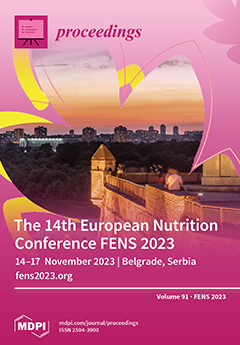Need Help?
Proceedings, 2023, FENS 2023
The 14th European Nutrition Conference FENS 2023
Belgrade, Serbia | 14–17 November 2023
Volume Editors:
Sladjana Sobajic, University of Belgrade, Serbia
Philip C. Calder, 1. University of Southampton, UK
2. NIHR Southampton Biomedical Research Centre, UK
- Issues are regarded as officially published after their release is announced to the table of contents alert mailing list.
- You may sign up for e-mail alerts to receive table of contents of newly released issues.
- PDF is the official format for papers published in both, html and pdf forms. To view the papers in pdf format, click on the "PDF Full-text" link, and use the free Adobe Reader to open them.
Cover Story (view full-size image):
The theme of the 14th European Nutrition Conference is “Food, Nutrition and Health: Translating science into practice”. Around this theme, the conference will deliver a high-quality
[...] Read more.
The theme of the 14th European Nutrition Conference is “Food, Nutrition and Health: Translating science into practice”. Around this theme, the conference will deliver a high-quality programme, featuring international speakers across plenary sessions and scientific symposia. Other features of the programme will be workshops, training sessions, industry symposia, and oral and poster sessions oriented towards early career researchers. This conference will provide opportunities to hear experts and to catch up on the latest science, as well as to become better informed about areas of controversy. The topics of the planned conference symposia are broad and multi-disciplinary and will appeal to all those interested in experimental, clinical, and public health nutrition.
Previous Issue
Next Issue
Issue View Metrics
Multiple requests from the same IP address are counted as one view.



